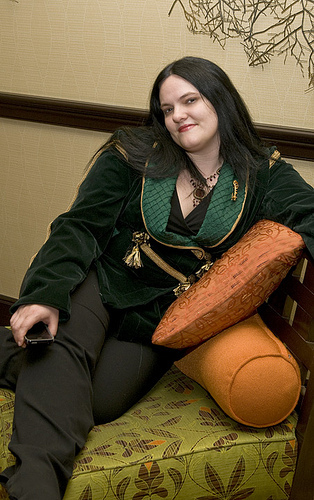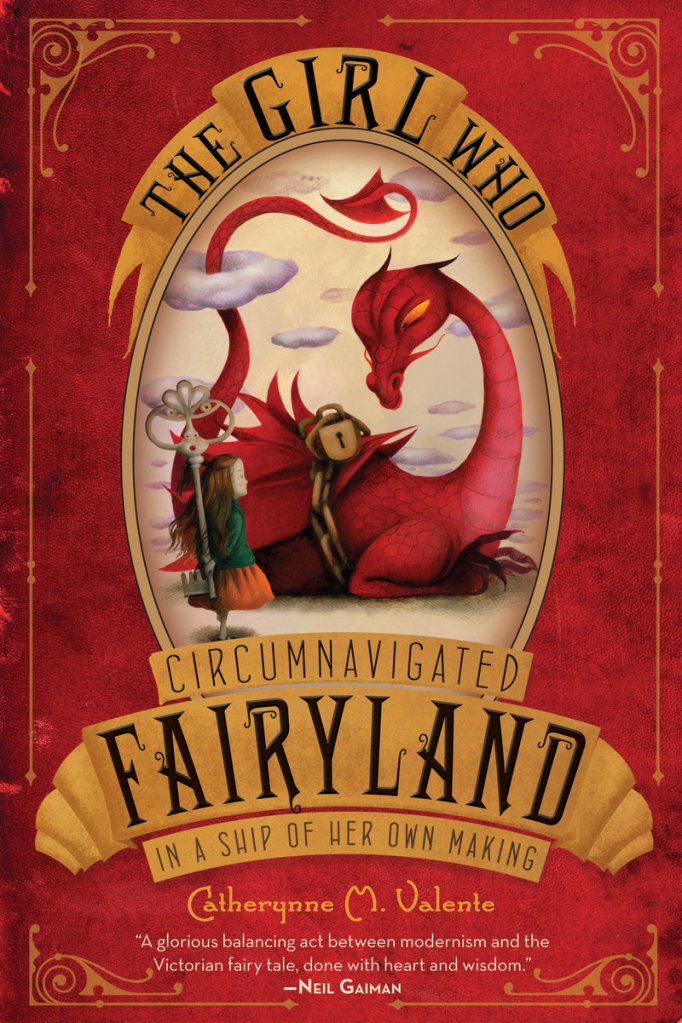People who live there think of Peaks Island as a magical place, but who would have guessed that it would give birth to a whimsical tale about a little girl’s adventures in Fairyland?
September, a 12-year-old from Omaha, is “The Girl Who Circumnavigated Fairyland In a Ship of Her Own Making” (Feiwel & Friends, $16.99). In the book, she is met at her kitchen window by a Green Wind, who whisks her off to Fairyland. While there, she encounters a power-hungry Marquess and a book-loving creature called a wyvern.
This fanciful tale sprang from the mind of Catherynne M. Valente, 32, the author of more than a dozen books of fiction and poetry. “Fairyland,” her first novel for young readers, has already won the Andre Norton Award for Best YA Science Fiction/Fantasy of the Year.
A West Coast native, Valente has lived on Peaks Island full time for almost three years. We caught up with her last week at the beginning of a California book tour.
Q: This is the day your book hits the shelves. How does that feel?
A: It’s really strange; stranger since I’ve been awake for God knows how many hours. I started flying at 5 this morning. But it’s been such a long road because it was published online in 2009, so it’s been two years of waiting for it to come out. It’s really sort of surreal.
Q: This novel began as a book within a book. Can you talk a little about its origins and how it ended up becoming a book of its own?
A: It’s a book within a book in “Palimpsest,” which is one of my more recent adult novels. That came out in 2009 as well. (“Fairyland” is) the protagonist’s favorite novel from when she was a little girl. Everywhere I went on tour, people said, “Is that a real book?” No, it’s not real, I just made it up for the novel. It’s fiction. And they said, “Well, when are you going to write it?”
And I said, “Never.” Who would ever publish such a thing, a YA book that was so strongly connected to this very adult book?
Time went by, and we had just moved to Maine when “Palimpsest” came out. And unfortunately, that was just about the time of the economic crash. My husband was working two jobs, and he was laid off from both within six weeks of each other. Oh yeah, it was brutal …
We were determined to stick it out in Portland, and so I thought, “This is the book everybody’s been asking to read.” So I started putting a chapter a week up on my website. Every Monday, I would post a chapter. And there was a little button that said, “donate whatever you think the book is worth. And if you don’t donate, still read it for free. Enjoy it. Read it to your kids if you want. It doesn’t cost anything to read, but if you feel like it, throw some money in the tip hat.” And it spread like wildfire. People really identified with the story, and they linked it around all over Twitter and Facebook.
A big blog started covering the story, and it was very, very successful. It won the CultureGeek Best Web Fiction of the Decade Award, which was absolutely mad to me because it was up against Dr. Horrible and Girl Genius and all of these things that are high-level geek culture. So I finished the book ahead of schedule, and my agent started shopping it around, and it was picked up by Feiwel & Friends shortly before it won the Andre Norton Award for YA literature, which is a major literary award. It’s the first self-published book to win a major literary award.
Q: With the success of publishing it online first, do you think you’d ever write another book that way? Do you think this is kind of the future of publishing?
A: You know, I don’t think it’s the future of publishing. Everything’s changing right now, and nobody knows how publishing is actually going to shake out.
But I think that it’s more of a hybrid approach that we’re going to see in the future. This is a classic example of a hybrid of something that has a life online and now has a completely new life in print. And I think that when you look at people like Amanda Hocking, who has just signed a major print publishing deal, print publishing isn’t going anywhere. It’s just going to have to change, the way the music industry changed and the movie industry is going to have to change, too.
Q: This was your first novel for young readers. How do you tap into that younger voice? Do you read other books written for that age group, or do you just think back to what appealed to you at that age?
A: In large part, it’s the book I wanted to read when I was little. I loved “Alice in Wonderland” and “The Neverending Story” and “Peter Pan.” I read all the classics of children’s literature and a lot of newer classics, like “The Last Unicorn” and Susan Cooper’s books. I just thought about what would be the best bedtime story read to me by the best storyteller? What would I have wanted to curl up into when I was little?
Q: You’ve said that this book is going to be a series. Have you already got the next book plotted out?
A: Oh, yeah. I’m about halfway through writing the next one, and I’ve got a bare-bones plot for the third one. I definitely think ahead with something like this. Where it’s for kids, you have to plot it more than you would an adult book that allows for more meandering and noodling around in the margins. Kids want to get from A to B a little faster. I outline these much more than I do my adult books.
Q: Is there an end in sight, or are you going to just keep on going until you feel like you’ve finished?
A: If I had my druthers, if I could choose how this would go, it would be my Oz series. I would be able to write a bunch of them. It’s a four-book arc that is in my head for September for this protagonist. And then I would like to switch protagonists, if I can do that, and do a “boy who” series that was in the same world but just a different kid, the way the “Discworld” or “The Wizard of Oz” series and all of those work.
Q: What is your writing life like on Peaks Island?
A: For this winter, I have rented the Umbrella Cover Museum as an office. So most mornings, I get up and I walk down to my office and I make a cup of coffee. There’s no wireless that reaches that building, so I have no distractions. I put on the same song that starts my work day every day, which is an odd song, but it’s called “A Glorious Dawn” and it’s by Symphony of Science. It’s a musical version of a bunch of lines from the old Carl Sagan “Cosmos” series. It’s just beautiful and optimistic and relaxing. And I work until I hit my goal for the day.
Staff Writer Meredith Goad can be contacted at 791-6332 or at:
mgoad@pressherald.com
Copy the Story Link
Send questions/comments to the editors.





Success. Please wait for the page to reload. If the page does not reload within 5 seconds, please refresh the page.
Enter your email and password to access comments.
Hi, to comment on stories you must . This profile is in addition to your subscription and website login.
Already have a commenting profile? .
Invalid username/password.
Please check your email to confirm and complete your registration.
Only subscribers are eligible to post comments. Please subscribe or login first for digital access. Here’s why.
Use the form below to reset your password. When you've submitted your account email, we will send an email with a reset code.